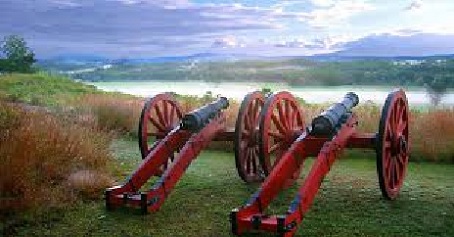

AVA CONVENTION RECREATIONAL BIKE RIDE
Saratoga National
Battlefield
648 Route 32
Stillwater, NY, 12170
Wednesday June 12 -
Friday June 14
Sanction #113621 Rated: 2A; GROUP BIKE on Thursday, June
13, 2019, 9:00 am


| If you choose, you may
conduct this ride on your own at anytime during the
convention. The following Group bike ride will start and finish at the Saratoga National Battlefield Visitor Center. Towards the end of the Battlefield loop road, bikers will have the option to return to the Start Point for a 10.7 mile (17.2) ride or continue on to include riding along the Hudson River and visit the Saratoga National Cemetery for a 17.6 mile (28.3 km) ride. Allow 2 to 3 hours for the ride depending on which option you choose and stops made. Please visit the Visitor’s Center at the top of the hill from the parking lot. You will find an excellent video, lighted display board depicting the battles, artifacts, gifts, great panoramic view, and bathrooms. There are also bathrooms at the cemetery. Helmets are also required. Bike Rental: A limited number of bike rentals are available from Plaine & Sons Bike Shop, 518-346-1433. Bikes need to be reserved in advance and will be delivered at 8:30 am to and picked up from the Start Point. Registration is made on the Convention website where you will identify if you need transportation and renting a bike. A group ride (and those renting bikes) starts at 9:00 am. Bus transportation will leave at 7:30 am for those renting bikes. A few words about the Saratoga
National Battlefield:
The Battle of Saratoga was named "most crucial battle of the last 1000 years" by New York Times Magazine in 1999. Here, in 1777, brave Americans decisively defeated an invading British army, winning a victory so powerful that it drew international allies and turned the tide to ultimately win America's War for Independence. Standing on a bluff above the Hudson River, it is easy to see why the terrain inspired confidence in the American troops in the fall of 1777. Knowing that British General John Burgoyne and his soldiers were heading toward Albany, N.Y., the Northern Army fortified its high position overlooking the key bottleneck of both the river and road. Except for the now-larger forests and the modern cars zipping down U.S. Route 4, little of the landscape that encompasses Saratoga National Historical Park has changed in almost 240 years. Understanding the terrain and using it to
their advantage, the soldiers under General Horatio Gates
secured a resounding American victory at Saratoga — and
began a chain reaction that ensured the country’s
independence for good. America’s victory gave rise to
international support, showcased the strength of a diverse
army, instigated the complex dichotomy of hero and traitor
and gave the country physical evidence of a successful
revolution. The multiplicity of lessons that can be
understood at Saratoga guarantees a personal connection to
not only America’s history, but to the impact that social
revolutions have had on this nation. (from the Civil War
Trust)
 A few words about the
Saratoga
National Cemetery:
Gerald B.H. Solomon Saratoga National Cemetery is New York State’s sixth national veteran’s cemetery and the 116th in the National Cemetery Administration. More than 1.4 million veterans live in New York and more than 225,000 reside in the Albany/Saratoga area. The first phase of construction, encompassing 60 acres of the 351-acre cemetery, included 5,000 grave sites, 2,000 lawn crypts, 1,500 columbaria niches and 700 garden niches for cremated remains. At full capacity, Solomon-Saratoga can provide burial space for 175,500 veterans and eligible dependents. On Jan. 24, 2002, President George W. Bush signed legislation renaming Saratoga National Cemetery as the Gerald B. H. Solomon Saratoga National Cemetery. Congressman Solomon was known as the champion of veterans' causes. Among his accomplishments, he spearheaded the effort to create the cabinet-level Department of Veterans Affairs and successfully led a drive to establish the national cemetery in which he is now interred. The cemetery also has a walkway that features a number of memorials erected by various veterans and fraternal organizations in honor of events and fallen comrades. (from the website for the cemetery). |